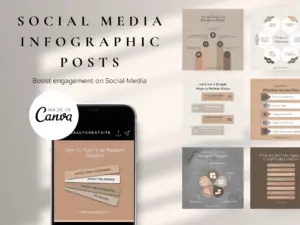In the fast-paced and ever-evolving landscape of the digital world, there’s a quiet yet intense race taking place behind the scenes.
It’s not about launching the next trendy app or creating the most viral content.
It’s about something more nuanced, yet immensely powerful: the strategy, know-how, and secrets behind successful digital products.
These aren’t your run-of-the-mill habits, but curated practices that the elite online circle tends to keep under wraps.
Here’s a glimpse into these closely guarded secrets that, when implemented, could elevate your digital product game to a professional level.
One of the primary secrets of successful digital product creators lies in the distinction between innovation and iteration.
The digital realm champions both, but knowing when to prioritize one over the other can determine the success of a product.
Iteration is a process of refinement—tweaking and improving an existing product based on user feedback and performance data.
Innovation, on the other hand, involves creating something new that catches the market by surprise.
Elite creators understand that constant innovation without proper iteration can lead to a backlog of unpolished or half-baked products.
Striking a balance between these two processes is crucial.
They go hand in hand; it’s the iteration that causes significant innovation and vice versa.
The secret here is paying close attention to consumer feedback and understanding subtle market shifts.
This dual focus allows digital products to not only meet existing demands but also anticipate future needs.
Another strategy that’s carefully wielded by top creators is the power of minimalism.
This isn’t about having bare-bones functionality, but about the art of doing more with less.
The elite understand that clutter in digital products can lead to confusion, loss of interest, and ultimately, user dropout.
By focusing on key functionalities and delivering with crystal-clear clarity, the user experience is immensely enhanced.
Designers and developers are encouraged to strip away non-essential features and aesthetics to highlight what truly matters.
Each click, scroll, or swipe is designed with intentionality, creating a seamless and satisfying user experience.
The practice of stealth marketing is another tactic that isn’t widely publicized but is embraced by successful digital product creators.
Stealth marketing revolves around subtle techniques that don’t feel like overt advertising.
This can include product placements, influencer collaborations without obvious promotional ties, and the integration of products within other platforms and services in a way that feels natural and organic.
The key lies in integrating the product so smoothly within the desired ecosystem that it becomes almost a default choice for users, without them realizing the marketing efforts behind it.
This strategy relies heavily on social proof and the inherent trust consumers have in their networks and reduces resistance to new products.
An often-overlooked component in digital product success is data mastery.
It’s not enough to collect gigabytes of user data; the real magic happens in interpretation.
Knowing how, when, and where a product is used can provide insights that are virtually impossible to get otherwise.
Elite creators employ data scientists to decode these behaviors into actionable strategies.
Advanced machine learning algorithms can predict user behavior, allowing companies to tailor products with an almost prescient accuracy.
They proactively predict user wants and needs before users themselves have even voiced them.
Success doesn’t come from blindly following data but interpreting it within the context of a broader vision.
Data tells a story, and successful digital creators are skilled narrators.
Collaboration isn’t always visible, but it’s often at the heart of products that dominate the digital sphere.
Co-creation with users, where a product is developed alongside the feedback offered by customers during beta testing phases, has become an insider’s tool.

The 3 Day Affiliate Marketing Challenge
Start & Launch Your First Online Business Using This Simple 3 Step System To Generate Commissions Every Day
Click To Learn More
This constant loop of feedback allows creators to fine-tune a product before its official launch, thus minimizing the risk of backlash and maximizing positive reception.
It turns users into brand advocates because they feel like they’ve been part of the creation process.
However, this isn’t just a public relations strategy—it’s a way to ensure a product is exactly what it needs to be without any assumptions.
Consider also the psychology of pricing.
Pricing a product isn’t a purely mathematical equation; it’s a psychological strategy too.
The elite digital creators are masters at utilizing scarcity tactics and anchor pricing methods.
By limiting access to a product and creating a sense of exclusivity, potential customers are more likely to perceive a product as valuable.
Furthermore, anchors—comparable products at a higher price point—make original prices appear as bargains.
These tactics leverage consumer psychology to boost perceived value and drive conversion rates.
The influence of community can’t be overstated when it comes to digital product success.
Elite creators don’t just build products; they nurture ecosystems.
A strong community not only provides continual feedback but also acts as free marketing through word-of-mouth referrals.
This type of organic growth is deemed more credible by new users who may perceive traditional ads with skepticism.
Established creators facilitate these communities to evolve around their products, offering platforms for sharing experiences and tips, which in turn increases product utility and value.
Experimentation is a bedrock of digital success stories.
The willingness to test and iterate upon new ideas bravely and at scale can propel a product toward explosive growth.
This willingness to fail and learn from those failures isn’t often showcased but remains a staple practice for most successful digital innovators.
There’s value in A/B testing, in trying multiple price points, UI designs, and feature combinations.
Knowing which experiments to focus on, however, requires experience and a deep understanding of both the product and its market.
Another factor often shrouded in mystery is the art of forecasting future trends.
The successful elites aren’t aligning their strategies with what’s trending now—they’re setting themselves up for what will trend next.
Analytics truly shine in this aspect, where sentiment analysis, social media monitoring, and macroeconomic factors come into play.
Spotting early signals allow innovators to seize first-mover advantages, cementing their places as category leaders.
Finally, never underestimate the power of branding.
Beyond logos and taglines, branding creates an emotional connection that bridges the gap between product functionality and customer needs.
The most successful digital products have an almost legendary aura, cultivated through a combination of compelling narratives and aligned customer experiences.
These narratives solidify the brand’s identity, ensuring that it resonates deeply with its audience on an emotional level.
In sum, the elite online circle’s success in digital products isn’t a stroke of luck or mere technical ability.
It’s a combination of strategic balance, psychological acumen, a focus on user experience, and the creation of authentic connections—both with users and through the product itself.
These secrets aren’t insurmountable for new creators who wish to elevate their craft; they are achievable practices, provided one approaches them with the right mindset.
While these insights give only a framework, applying them with finesse and attention can take any digital product from concept to world-renowned with time, patience, and determination.




















